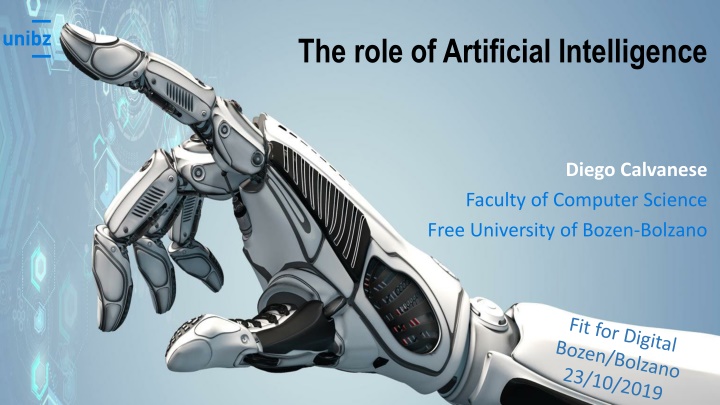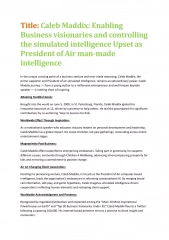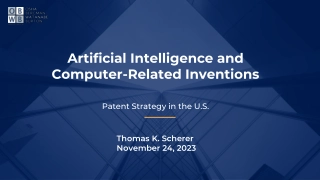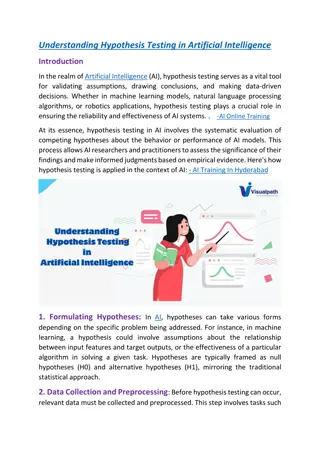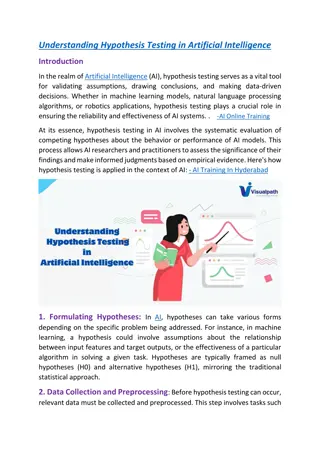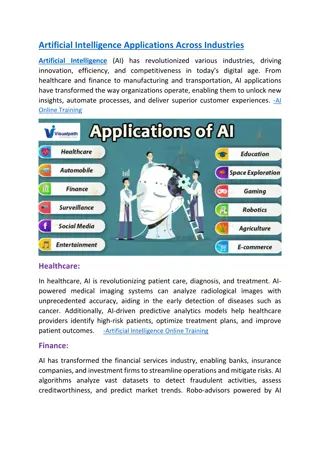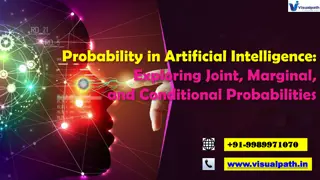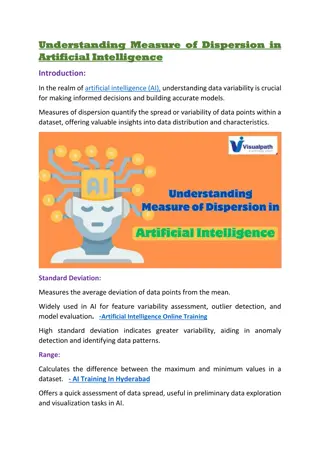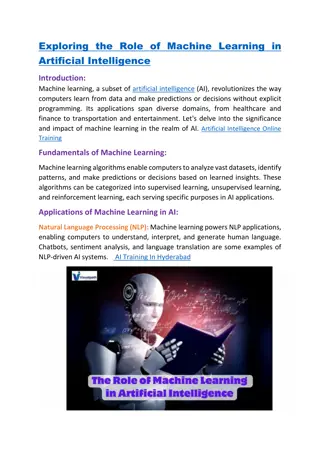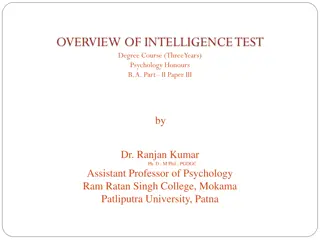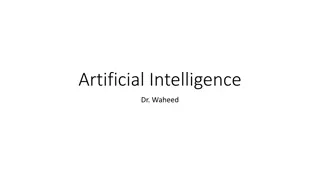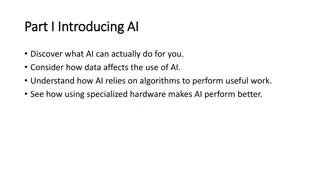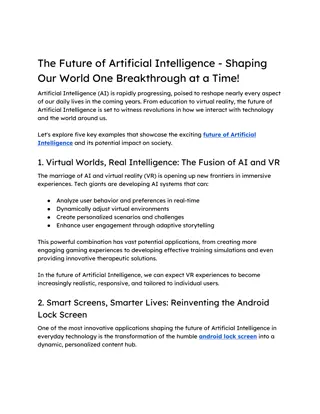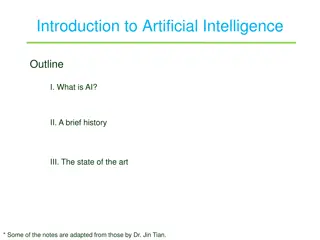The role of Artificial Intelligence
Artificial Intelligence (AI) has significantly impacted the job market by automating routine tasks and creating a competitive environment between humans and machines. This shift has led to concerns about job loss, economic growth, and the potential for inequality in decision-making processes. Recent progress in AI has been made possible by advancements in machine learning, increased computing power, availability of big data, and the development of deep learning techniques.
Download Presentation

Please find below an Image/Link to download the presentation.
The content on the website is provided AS IS for your information and personal use only. It may not be sold, licensed, or shared on other websites without obtaining consent from the author.If you encounter any issues during the download, it is possible that the publisher has removed the file from their server.
You are allowed to download the files provided on this website for personal or commercial use, subject to the condition that they are used lawfully. All files are the property of their respective owners.
The content on the website is provided AS IS for your information and personal use only. It may not be sold, licensed, or shared on other websites without obtaining consent from the author.
E N D
Presentation Transcript
The role of Artificial Intelligence Diego Calvanese Faculty of Computer Science Free University of Bozen-Bolzano
AI is everywhere 23/10/2019 - Diego Calvanese Fit for Digital 1
AI is everywhere 23/10/2019 - Diego Calvanese Fit for Digital 2
AI and the job market AI and the job market Robots have automated routine jobs, but so far, new jobs have been created to replace old ones. With AI, we are facing a completely new situation: Humans need to compete with machines that can outperform them in almost anything. Economic growth is decoupled from job creation. AI creates a Winner-takes-all environment. Many jobs are at high risk of automation in the next 10-15 years. https://willrobotstakemyjob.com/ 23/10/2019 - Diego Calvanese Fit for Digital 3
AI in decision making AI in decision making Selection of job applicants Performance evaluation Predictive models for crime College admission In all these domains availability of big data and application of AI techniques may increase inequality, bias, und unfair treatment. Cathy O Neil. 20116 23/10/2019 - Diego Calvanese Fit for Digital 4
What made the recent progress in AI possible? What made the recent progress in AI possible? The underlying technology has been developed over 50 years ago: quantitative (mostly statistical analysis) approach relying on machine learning What changed is the scale at which machine learning can now be applied: greatly increased computing power Moore s Law and the cloud availability of enormous amounts of data Also: development of new statistical techniques deep learning. Turing Award 2018 to Y. Bengio, G. Hinton, Y. LeCun 23/10/2019 - Diego Calvanese Fit for Digital 5
Machine/deep learning Machine/deep learning A toy example A toy example The aim is to capture the input/output behaviour of a system through a suitable function. Example: recognition of a digit written in a 28x28 matrix of pixels 784 inputs, one for each pixel 10 binary outputs, each one signaling a digit Function represented through weights on connections between nodes. A node becomes active if the input signal is above a threshold. Learning task is to determine the weights that provide the correct output. 23/10/2019 - Diego Calvanese Fit for Digital 6
Machine/deep learning in the real world Machine/deep learning in the real world Online systems: face recognition, natural language understanding, online translation, autonomous vehicles, ... Inputs: come come from the various types of sensors Outputs: recognition of a face, natural language text, actions, ... Offline sytems: decision making, profiling, classification, ... Input: data about the new case/situation to be analyzed Output: decision taken, classification 23/10/2019 - Diego Calvanese Fit for Digital 7
The role of data The role of data There are different approaches with which AI systems learn the input/output behaviour: Unsupervised learning Supervised learning Reinforcement learning In all cases, we need huge amounts of data for training. 23/10/2019 - Diego Calvanese Fit for Digital 8
Is data all we need? Is data all we need? 23/10/2019 - Diego Calvanese Fit for Digital Bolzano CS Meets Business 9
We have to be careful with data 23/10/2019 - Diego Calvanese Fit for Digital 10
Causality vs. correlation Causality vs. correlation 23/10/2019 - Diego Calvanese Fit for Digital Bolzano CS Meets Business 11
Causality vs. correlation Causality vs. correlation 23/10/2019 - Diego Calvanese Fit for Digital Bolzano CS Meets Business 12
A problem with big data: the long tail A problem with big data: the long tail There are situations where big data do not help. Long tail phenomenon: Rare events play an important role. British National Corpus (108words): 1,7% occur 10 times. Search traffic on the Web: 70% is on keywords with 10 monthly occurrences [Hitwise] To take this into account, we need to abstract and apply general principles, i.e., make use of knowledge. 23/10/2019 - Diego Calvanese Fit for Digital Bolzano CS Meets Business 13
The meaning is important, not just the data The meaning is important, not just the data Mars Climate Orbiter (1999) Probe sent to Mars Cost of mission: 327M Probe got lost when entering Mars orbit. Problem: different teams of engineers used different measurement units. 23/10/2019 - Diego Calvanese Fit for Digital Bolzano CS Meets Business 14
Ask Alexa! Ask Alexa! Chi Diomede? un personaggio della mitologia greca, che si distinto come guerriero nella guerra di -BIP-. Alexa has only a syntactic understanding of the terms about which she provides answers. She lacks knowledge, i.e., an explicit model of the data. 23/10/2019 - Diego Calvanese Fit for Digital 15
Having the wrong model can cost a lot! Having the wrong model can cost a lot! It was a $3.5 billion question: was the crashing of two aeroplanes into New York s twin towers in September 2001 one event or two? Thanks to Giancarlo Guizzardi for this nice example! 23/10/2019 - Diego Calvanese Fit for Digital Bolzano CS Meets Business 17
We need more than data 23/10/2019 - Diego Calvanese Fit for Digital 18
Not only data, but also knowledge Not only data, but also knowledge We humans constantly use background knowledge in our daily life. Knowledge involves data, but data alone is not sufficient. Knowledge is represented and stored as symbolic expressions. The expressions are manipulated according to some general logic based rules, to derive new symbolic expressions that form new knowledge. Knowledge Representation Hypothesis Achieving intelligent behavior requires to store and to manipulate symbolic knowledge. 23/10/2019 - Diego Calvanese Fit for Digital 19
Where do the data come from? Where do the data come from? Public administrations collect and own lots of data! But to exploit data, it needs to be integrated available in a single place represented in the same formats, both logically and conceptually cleaned and reconciled Models are key! KR in AI deals with models models of the data, to understand what it is about models of the processes, to understand how data should and actually is used 23/10/2019 - Diego Calvanese Fit for Digital 20
Thanks for your attention 23/10/2019 - Diego Calvanese Fit for Digital 21
